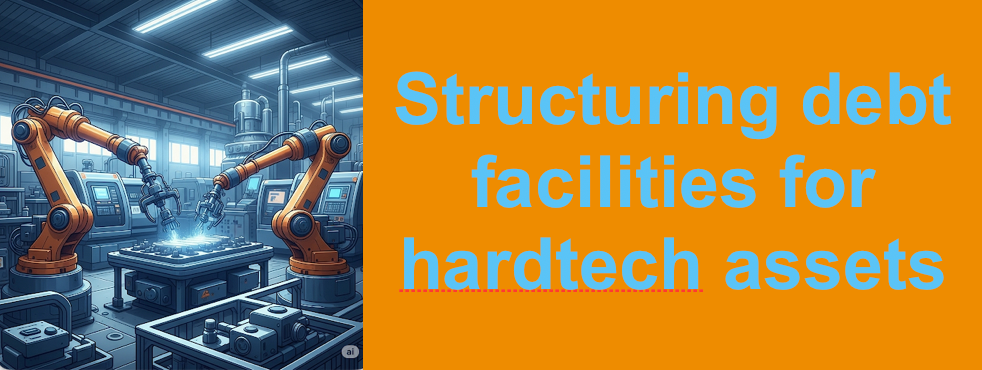HICP Team • July 29, 2025
Structuring debt facilities for hardtech assets
Why traditional credit lines don’t work for hardtech—and what does

Structuring debt facilities for hardtech assets—such as manufacturing equipment, robotics, clean energy infrastructure, or deeptech systems—requires a fundamentally different approach than traditional credit lines. This is because hardtech ventures often have unique financial profiles, asset characteristics, and risk profiles that are poorly served by conventional lending models.
Here's a structured breakdown of why traditional credit lines don’t work for hardtech—and what does:
❌ Why Traditional Credit Lines Don’t Work
1. Lack of Cash Flow
- Traditional credit facilities (like revolvers or working capital lines) are underwritten based on predictable cash flow.
- Hardtech ventures often have long R&D cycles, capital-intensive prototyping, and delayed revenue realization.
- Early-stage hardtech companies often operate pre-revenue or with lumpy, project-based revenues.
2. Non-Liquid Collateral
- Lenders prefer
liquid, easily-valued assets (like accounts receivable or inventory).
- Hardtech companies have specialized equipment, IP, or prototypes that are illiquid and hard to value or resell.
- Hard assets like bespoke robotics, 3D printers, or pilot-scale reactors may be mission-specific.
3. Misaligned Time Horizons
- Traditional loans require repayment over 12–36 months with strict covenants.
- Hardtech infrastructure (e.g., battery manufacturing or fusion testbeds) often takes 3–10 years to reach profitability.
- Repayment schedules don’t match asset productivity curves.
4. Covenant and Risk Intolerance
- Traditional lenders apply rigid covenants and penalize variance.
- Hardtech ventures experience inherent technical risk, longer development cycles, and stepwise milestones, not linear progress.
✅ What Works Instead: Purpose-Built Structures for Hardtech
1. Asset-Based Financing (with Enhanced Underwriting)
- Custom asset-backed loans against specialized equipment.
- Requires
technical underwriters to assess asset value, redeployability, and use-case.
- Example: Equipment financing tailored for additive manufacturing tools or cryogenic systems.
2. Project Finance / Infrastructure Debt
- Long-term, non-recourse debt secured by project-level SPVs.
- Ideal for energy, climate tech, or industrial hardtech with long-life assets.
- Tied to offtake agreements (e.g., power purchase agreements or service contracts).
3. Revenue-Based Financing (RBF) / Royalty Loans
- Repayment tied to actual revenue performance.
- Protects lenders from timing risk and reduces strain on early-stage hardtech firms.
- Works well where revenues are episodic or project-based.
4. Government-Backed Loan Guarantees
- Public sector credit enhancement (e.g., DOE Loan Programs Office, Export-Import Bank).
- Unlocks private lending by derisking deployment capital.
- Especially relevant in cleantech, defense, aerospace, and semiconductors.
5. Milestone-Based Tranches
- Debt disbursed in phases tied to technical or commercial milestones.
- Aligns lender exposure with de-risking.
- Works well when tech validation precedes deployment (e.g., pilot to production).
6. Blended Capital Stacks
- Combining debt, grants, and concessional capital to unlock commercial lending.
- Structures include first-loss protection, interest rate buy-downs, or subordinated mezzanine layers.
- Common in climate finance, advanced manufacturing, and deeptech industrial projects.
7. Sale-Leaseback Models
- Company sells equipment to a financier, then leases it back (capital-light structure).
- Preserves cash while allowing use of the asset.
- Especially useful for hard assets like lab equipment, CNC machinery, or cleanrooms.
🔑 Keys to Success
- Specialized Lenders or Partners: Need debt providers with domain expertise in hardtech.
- Longer Tenors + Flexible Covenants: Align debt structure to asset maturity and technical inflection points.
- Integrated Risk Sharing: Leverage insurance, guarantees, or shared upside mechanisms.
- Emphasis on Strategic Assets: Focus on assets that enable high-margin recurring revenue (e.g., manufacturing as a service, robotics platforms).


